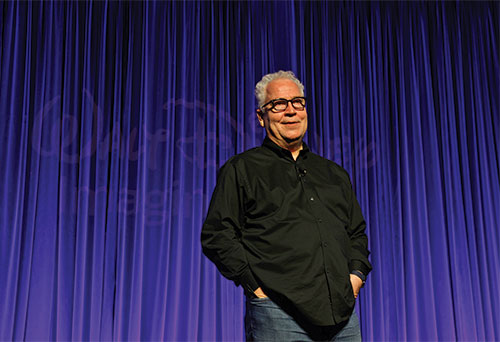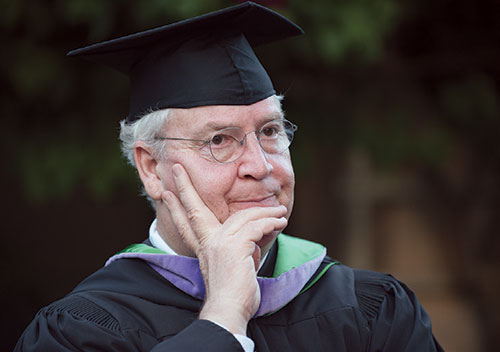Active Imagineering
Alumnus Bob Weis Taps Creativity, Diversity and Imagination to Create Disney’s Theme Parks
By Monica Rodriguez Every year, millions of Disney theme park guests around the world experience fantastic places that at one time existed only in storybooks, films and people’s imaginations.
Every year, millions of Disney theme park guests around the world experience fantastic places that at one time existed only in storybooks, films and people’s imaginations.
Those immersive experiences are the result of designers, artists, engineers and other creatives led by Cal Poly Pomona alumnus Bob Weis, president of Walt Disney Imagineering. Weis (’80, architecture) began working for Disney after graduation, launching a career that has been pivotal to some of the company’s biggest projects, including the construction of Tokyo Disneyland, the transformation and expansion of Disney California Adventure and the creation of Shanghai Disney Resort.
Tokyo Disneyland, the first Disney presence in an international theme park, came early in Weis’ career and taught him the value of diversity and inclusion.
“We found so many talented people in those early days in Japan to work with us,” Weis says. “I took that experience with me to Paris, Hong Kong and Shanghai. Wherever you go, there are passionate people who believe in doing great things. And if you open yourself up to allow those different points of view in, it’s a much richer project that gets created.”
In preparation for Shanghai Disney Resort, Weis and his team visited schools and homes in China, and discovered that people were familiar with Disney cartoons, characters and stories and are family-oriented.
“They want to do things together with their families. They want to have fun together. They want their kids to have enriching experiences,” Weis says. “What we do seems to be accepted around the world because we put that care into it, because our focus is families being together and that goes all the way back to our early history.”
The Power of Stories
The work of Walt Disney Imagineering is driven by storytelling, a practice started with Walt Disney.
Disney, whose background was in animation, wanted to build a theme park and sought the advice of Welton Becket, a renowned Los Angeles-based architect responsible for some of the city’s most iconic structures, including the Capitol Records building, the Cinerama Dome and the Los Angeles Music Center.
Disney asked Becket whom he should hire tomake his dream a reality.
“Welton Beckett told him, ‘You cannot hire a traditional design company to do this because what you’re doing is something different. You’re making, in effect, a kind of a movie that people are going to be in and they’re going to have their own experience in it,’ ” Weis says. “So, from the very beginning our work has always started with a storyline.”
The award-winning designer says he “won the golden ticket” when he was hired by Imagineering after graduation. Although he didn’t have a long resume, he had energy, passion for the entertainment field and a degree from a university that was “very diverse in disciplines and people.”
For Imagineers, the first step to creating an attraction or theme park is defining the story and telling it one scene at a time. For the Star Wars Galaxy’s Edge land, which opened in 2019 in California and Florida, teams addressed numerous aspects of the project — story planning, entertainment experience, types of rides and the variety of food in the restaurants.
“As a designer in Imagineering there are very few boundaries,” Weis says. “We’re a very multi-discipline group but we’re incredibly collaborative. Even a young designer, coming in like I did many years ago, has the opportunity to interact with so many interesting people and be a part of the dialogue.”
Finally, after years of planning and design, the payoff moment is watching parkgoers — especially children — experience the park for the first time.
“(These projects) take a lot of your life. Your focus, lots of energy, lots of your time,” Weis says. “When you finally get that opportunity to see the audience come in, it’s really emotional because it feels like, ‘Oh, all those years were worth it.’ ”
An International Success
Creating a park or attraction overseas requires writers and designers who understand their local audience. Even designing something within the United States, say Southern California, requires just as much care, if not more, because California is home to a culturally diverse audience, Weis says.
To create something, designers must put themselves into park guests’ shoes.
That means making sure visitors can easily understand signs, providing guides who speak the audience’s language, showing photos and images of people who represent the audience, and providing food that meets cultural and dietary requirements.
“A lot goes (on) behind the scenes making sure that we have accounted for the breadth of audience, and we’re privileged to have such a broad audience,” Weis says. “But with that privilege comes a responsibility to have diverse enough points of view on the creative team to make sure you can really meet that challenge.”
Diversity and inclusion are critical to Imagineering’s work. A workforce that is culturally diverse and from different backgrounds is better able to provide positive experiences for guests, while keeping a company known for creativity and innovation on the cutting edge. It’s critical that people feel safe at work so they can present varying points of view and new concepts, and also feel their colleagues are receptive. Students coming out of colleges and universities should be ready to work with people with ideas different from their own, Weis says.
Similarly, he challenges his teams to reach for the impossible and not limit their imagination.
“There’s a great Walt Disney quote that we love so much here, which is: ‘It’s kind of fun to do the impossible.’ ”
“We have people here who are scientists and writers and artists and sculptors and such a wide range of engineers. If you can put those folks in a room and really let them imagine and let them push the envelope and what they’re imagining, they’ll come up with great things. And then it’s our job to figure out how to do them.”
The Polytechnic Advantage
 Cal Poly Pomona and its faculty played a significant role in Weis’ education and career path.
Cal Poly Pomona and its faculty played a significant role in Weis’ education and career path.
He learned to think problems through, process information effectively and give presentations. It’s where he learned to interact with people who had different ideas.
Most of all, Weis remembers his instructors as inspiring and supportive.
One of many faculty members Weis fondly recalls is the now retired Michael DeVine, who taught in the university’s Department of Theatre & New Dance in addition to being a highly regarded scenic designer in the entertainment industry.
“He actually looked at my drawings and he said, ‘You know you can stay in theater but you’re not going to leverage as much of your design ability as if you were to go get a degree in architecture. Then you can come back to entertainment,’” says Weis, who entered as a theatre major his freshman year.
Weis had never thought about earning an architecture degree, but DeVine’s encouragement prompted him to change course.
“He led me in that direction based on what he saw in me. I’m not sure I ever would have done that on my own,” Weis says. “I think those instructors have insight into you at that time that you don’t even have into yourself yet.”
Now it is Weis’ turn to pay if forward.
Each year Weis and other Imagineers volunteer their time to interact with architecture through the Bobby Brooks Memorial Interdisciplinary Design Studio at Cal Poly Pomona. The program, established in honor of alumnus Bobby Brooks, a friend and fellow Imagineer who died in 2008, gives students the opportunity to solve a design challenge.
Disney representatives visit the university, meet with students, review their projects and collaborate with them. The program provides a platform for students to showcase their passion and hard work.
“That’s always amazing as an inspiration for us because you see how these incredibly talented young students handle a problem, often with very fresh ideas than what we might not have originally thought of,” he says. “It’s inspiring to see how hard they work and the technical skills that students have in addition to their artistic and design skills and their passion.”


